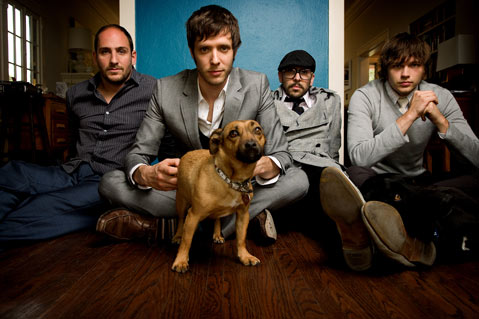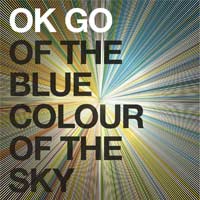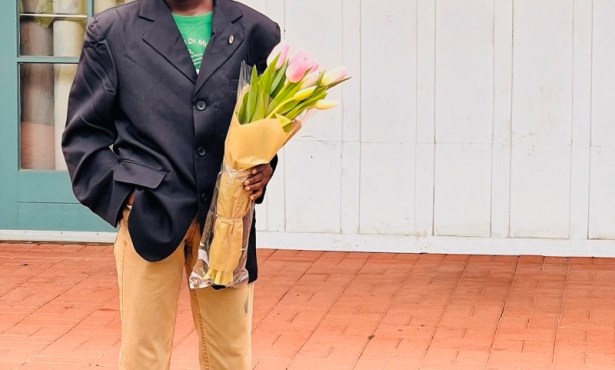OK Go Get Weird on Album Three
Pop Rockers Bring Of the Blue Colour of the Sky to UCSB

Let’s face it: When you hear “OK Go,” you think “treadmills” (and possibly vice versa). The Chicago-born, L.A.-dwelling four-piece has been churning out brainy pop rock since way back in 1998, but it wasn’t until 2006’s gravity-defying, treadmill-dancing video for “Here It Goes Again” that folks really started paying attention. Since then, the guys (Damian Kulash, Tim Nordwind, Dan Konopka, and Andy Ross) have scored a Grammy nod for Best Short-Form Music Video, hooked up with Olivier (brother of Michel) Gondry, and toured their butts off, with everyone from Snow Patrol and Panic! At the Disco to Motion City Soundtrack.

Still, it wasn’t until January of this year that the lads of OK Go would release a follow-up to their 2005 breakthrough album, Oh No. The result, Of the Blue Colour of the Sky, is an impressively ambitious departure from OK Go efforts of the past. Helped along by producer and oddity lover Dave Fridmann (MGMT, The Flaming Lips, Black Moth Super Rainbow), Of the Blue Colour finds the band exploring everything from children’s-choir chant-alongs to spacey, Bowie-infused psych rock, as well as the requisite music-video mindboggle: a massive Rube Goldberg machine they built and synched up to the single “This Too Shall Pass.” It’s an album as unexpected as they come. But, better yet, it’s an album that could push OK Go out from under the shadow of “Here It Goes Again.” I recently spoke with drummer Konopka about the album, new producer Fridmann, and life after music-video stardom.
What was it like to get back in the writing groove after touring so relentlessly for Oh No? It was tough at first to get into the writing of this record, mostly because we were pretty burnt out and spent. People had personal issues going on after having been gone for two-and-a-half years. On top of that, we toured for two-and-a-half years but also spent a year making Oh No, and then it took a year for it to come out, so it really was about four years in between writing times. When we sat back down to write again, the things that used to inspire us and get us excited just weren’t really doing it anymore. I think we were first trying to write songs that met the expectations of what we were supposed to sound like, instead of writing things based on how we wanted to sound, or how we were feeling at the time. We were writing a bunch of crap, basically, that just sounded like us covering us.
Of the Blue Colour seems quite the opposite of that. How did you guys get there? We just kind of stripped everything down and started over again, and wrote very primitively. We’d write beats and grooves, things like that, and if some beat with the sound of a piano equaled something greater than the sum of its parts, if there was some sort of alchemy there and emotion, we deemed that idea worthy of working on. So that led to a somewhat groovier-sounding record in general. It’s much more dancey than anything we’ve ever written before. There are sort of two sides to the record; there’s the dark, dancey side, and then there’s this more spacey, dreamy, on-the-porch acoustic side à la Neutral Milk Hotel or The Flaming Lips.
You mention The Flaming Lips. I’m curious to know what role Dave [Fridmann] played in the recording process. He had a big hand in it. We’ve actually always tried to work with Dave, but our schedules never matched up. But this time around, we were definitely writing songs that were very sort of Dave Fridmann-esque. It was this sort of weird, psychedelic dance music. So when we found out that he was available and wanted to work on it, it just seemed like a no-brainer. He holds the keys to this very three-dimensional, psychedelic sonic universe, and everyone does something different with it, but there’s no doubt his fingerprints are all over this record. … He was a big proponent of “go big and go weird.” He did not give a shit whether anyone but us was going to like it, which was a nice safe zone to be in, because I don’t think we can escape having that feeling of, “I hope people like this.” He was just like, “If it sounds awesome to you, then it’s awesome.”
Speaking of awesome, can you tell me a bit about the making of the “This Too Shall Pass” video? Our guitarist, Andy Ross, sent around this Rube Goldberg machine YouTube clip to all of us in the band and sort of suggested that we could do something like it. So we started discussing it and thought, you know, it would be really cool if we could get this thing to dance with the music and have it be synchronized to the music. … So Damian wrote up a job description and put it up on some science message boards and we got a proposal back from this group called SynLabs, which is this science collective in L.A., about how they wanted to build this gigantic Rube Goldberg machine that would span three floors of a building. And we thought, “Wow, but we can’t afford to pay 20 people to do this.” And they said, “Don’t worry about it; we just want to see this thing get made.” So we spent about two months just coming up with bits and pieces of what we wanted to happen, and then we rented this warehouse space and they went in and started building. It was a huge ordeal; we started with about 20 people, and at the end, there were probably 60 volunteers trying to get that thing to work.
4•1•1
OK Go play UCSB’s Hub this Friday, November 19, at 9 p.m. For tickets and info, call 893-2064 or visit facebook.com/asprogramboard.



